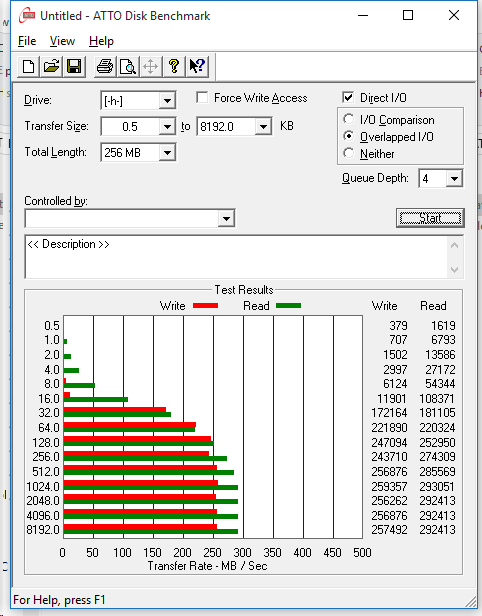ATTO Disk Benchmark is a relatively easy-to-use benchmark tool. ATTO Disk Benchmark relies on testing different file sizes with highly compressible data. Although this is not the best representation of media files which are, for the most part, highly incompressible, it is a good start and is still the main mechanism most manufacturers use to determine their product specifications. In our testing, we have left the benchmark settings to default.
 As we can see from the results above, ATTO reports max read speed of 293MB/s. This is just 7MB/s short of the maximum rating. For write speed we see 259MB/s. Overall, performance is quite impressive.
As we can see from the results above, ATTO reports max read speed of 293MB/s. This is just 7MB/s short of the maximum rating. For write speed we see 259MB/s. Overall, performance is quite impressive.
CRYSTAL DISK BENCHMARK VER. 4.0.3 X64
Crystal Disk Mark is visually straightforward and is used for measuring the speeds at which your storage device reads and writes with random, mostly incompressible, data. Random data is more consistent with everyday use of a computer, such as transferring videos, pictures and music. Thus, this benchmark will be a better representation of speeds to expect on a video or stills camera over ATTO.
 Crystal Disk Mark testing with its random data shows us similar write speeds reported by ATTO at 255MB/s, but reads are a bit less reaching 257MB/s.
Crystal Disk Mark testing with its random data shows us similar write speeds reported by ATTO at 255MB/s, but reads are a bit less reaching 257MB/s.
ANVIL’S STORAGE UTILITIES PROFESSIONAL 1.1.0
Anvil’s Storage Utilities is the best software program available for benchmarking flash media. Not only does it give an accurate look at transfer speeds and throughput, but also, it goes even further by identifying file sizes, disk access times, as well as system and device identification. It even has many extra features such as endurance torture testing and a TRIM button feature to manually trigger TRIM on supported devices.
Finally, in our last test, we see that Anvil shows read speeds in between what both ATTO and CDM showed, reaching 276MB/s. Write speed still maintained about 250MB/s.
 The SSD Review The Worlds Dedicated SSD Education and Review Resource |
The SSD Review The Worlds Dedicated SSD Education and Review Resource | 
There is a big difference for maximum IOPS compared to the fastest SanDisk Extreme.
https://www.thessdreview.com/featured/sandisk-extreme-pro-uhs-ii-memory-card-review-16-gb/2/
Anything smaller than 32KB per transfer is much slower with the Lexar. The 4K R/W performance gap is 2.9/26.5 -vs- 57.5/143.7 MB/s (Lexar -vs- SanDisk). 256KB sequential R/W speed favours the Lexar but real world cameras don’t seem to use the pattern (more like 32KB ?). The SanDisk low write latency is great, however the small read performance and higher queue depths are not optimised.
When it comes to cameras all that matters is large block sequential speeds. Small block performance is useless.
If you are right then why does the SanDisk beat the Lexar when in a camera, albeit camera not UHS-2 compatible, Queue=1? The high seq benchmark has little indication of real world in camera performance.
Well, we didn’t compare the SanDisk UHS-II card. That was against an older UHS-I card. Also, the numbers on the chart are rounded. The SanDisk on the chart = 7.43s while the Lexar = 7.64s average…not really much of a difference, but you can see that after rounding the SanDisk = 7 seconds while the Lexar – 8 seconds.
Even if we did compare the SanDisk UHS-II card, we would still be comparing them in a non-UHS-II camera and they would be running at UHS-I speeds. You can’t really show how much better one card vs another is in that bench when they are actually capable of so much more speed. I just included it to show that there weren’t any inherent slow down issues that I have seen with other cards in the past. Essentially I look at that graph and conclude that all perform practically the same. Unless one takes significantly longer, varying 1-2 frames doesn’t really matter.
Two weeks ago I bought 2 Lexars card: 64GB Professional 2000x UHS-II SDXC and XQD 2933x 128Gb. XQD – ok; about SDXC you could see down:
1. Look good. All the next – bad.
2. Speed. Testing system – MacBook Pro; 16Gb 1600 ?Gz DDR3RAM; 2,8 GHz Intel Core i7; Intel Iris Pro 1536Mb; SSD PCIe 1024Mb.
Reading from Lexar – volume of 27195Mb NEF (Nikon raw photo format) files, approximately 20-30Mb each separate file. First: without card reader – reading time 322s => 84,46Mb/s. Second: throw the special Lexar USB card reader – 687s => 39,59Mb/s. It’s a pity.
Writing to Lexar – the same as reading. First: without card reader – reading time 358s => 75,96Mb/s. Second: with Lexar card reader – 800s => 33,99Mb/s.
As alternative I tested SanDisk Extreme Pro 64Gb (95Mb/s). Conditions – as previous case. Without card reader. Reading time 317s => speed 85,79Mb/s. Writing – 357s => 76,18Mb/s. Very interesting!
3. Reliability. Testing camera – Nikon D500. When I took a photo and them saw a preview, camera gave Error: “SD This memory card cannot be used. Card may be damage. Insert another card.” It’s awful.
Sometimes card work, but has slow camera preview reading speed.
Card formatted in camera.
Aleksandr
You got a bad card. It happens but in no way is it reflective of the card as a whole. My main go to for my D600 is the Lexar and I can tell you it has been totally reliable, and speedy, for two plus years. Trust me when I say that I put more media through that card than most and it is used daily.
Thank you 🙂
Have a good photo!
You too. Sorry about your experience!
Dude are you FFF serious? The Samsung NX1 supported the SDXC UHS-II standard in 2014… And the Samsung NX500 right after.